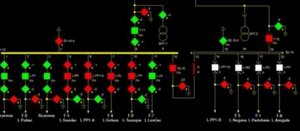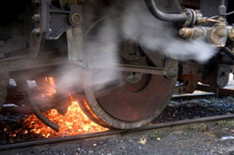Railroads and IoT – Part 1
Does the railroad safety story seem to repeat over and over?
On Feb. 3, 2023, a Norfolk Southern train carrying toxic chemicals derailed in East Palestine, Ohio, igniting a fire and setting off fears of an explosion. The authorities carried out a controlled release and burn-off of some of the train’s hazardous cargo (the black plume is toxic vinyl chloride), but residents on both sides of the Ohio-Pennsylvania state line are concerned about the impact on their health and the environment. (Photo: Gene J. Puskar/Associated Press)
We’ve watched the Ohio railway tragedy of 2023 unfold with growing frustration. Railroads have always seemed slow to change and resistant to innovation. Regulations and legal decisions have often decreased liability for accidents and injuries that makes it easier to absorb legal judgments as a normal cost of business.
In June 2023, a train derailment/bridge failure dumped railcars containing liquid asphalt and molten sulfur (what we used to call ‘brimstone’) into Montana’s Yellowstone River. It is not yet clear what failed or the sequence of events that caused this cascading failure and pollution of this scenic river. According to the Montana news story, two tanker cars with materials posing a greater hazard did not land in the river. (Photo credit: Matthew Brown/AP)
IoT has transformed many industries but railroads still face systematic risk traceable to a lack of comprehensive instrumentation. What are some symptoms and what could be done?
We will discuss the Norfolk Southern CEO’s proposed fix. We suggest alternatives in Railroads and IoT Part 2.
History: A short personal encounter with railroads
My frustration dates back several decades. I was invited to interview with a major railroad when I was a freshly-minted electrical engineering undergraduate. Many industries were benefiting from an instrumentation revolution and it seemed that the complex scheduling, roadbed hazards, and vast inventory of rolling stock would make it ripe for that revolution.

 I had learned a lot about Supervisory Control and Data Acquisition (SCADA) in the electric power industry: monitor, measure, and manage a far-flung network of power stations and customers.
I had learned a lot about Supervisory Control and Data Acquisition (SCADA) in the electric power industry: monitor, measure, and manage a far-flung network of power stations and customers.
During the interview, we talked about the idea of building instrumentation into trains. The manager said that, at the time, they monitored the trains and their contents, but little on each rail car. An important device was infrared ‘hot box’ detectors staged next to the track that tried to measure the temperature of the wheel bearings of the train going by. If it was hot, it would start a multistep system of notification, ending with the train crew.
Train cars had this problem for over 100 years with numerous derailments and damage caused when axles broke or seized up. In the 1800’s, workers would walk along trains looking for smoke or fire coming from the railcar.
Sometimes, hot box detectors may not detect a problem in a car moving 60 miles per hour because of ice, snow, water, mud, incorrect calibration, or the railcar problem may crop up between detectors spaced 25 miles apart. The interviewing manager said that, at the time, workers sometimes had to clean out actual rats’ nests that were built inside the detector.
I asked, “Why can’t we put simple instrumentation on each railcar to measure a few metrics, starting with four bearing journal temperature sensors, ID’s, and door or valve position? It might pay for itself in a single prevented derailment.” The manager said that things like that had been suggested but no action had been taken.
starting with four bearing journal temperature sensors, ID’s, and door or valve position? It might pay for itself in a single prevented derailment.” The manager said that things like that had been suggested but no action had been taken.
My interview ended in the sales room, where rows of desks faced huge golden letters on the far wall—YCSFSOYA. It was an important part of the interview.
Back to today and alternatives
Railroads combine high value goods, high systematic risk to things and people, limited human supervision, hard-to-control factors like ice or component wear-and-tear, and a range of shippers’ requirements from low-profit coal to high-profit automobiles. It seems like a great fit for IoT.
According to an Ohio news story, the two-mile-long train passed two hot box detectors without detection, then a third detector detected the overheated bearing but it was too late to notify the train crew. There is a video of sparks over 10 feet long flying from the stricken bearing/axle/wheel before the derailment.
Norfolk Southern CEO’s proposed fix to Congress—decrease hot box detector spacing from 25 miles to 10 miles—makes incremental changes to a 70-year-old solution that is apparently suboptimal for even a small subset of problems.
We respectfully disagree. We offer an alternative in Railroads and IoT Part 2. Wouldn’t it be great if a railroad visit today ended in a big room with huge golden letters that said: